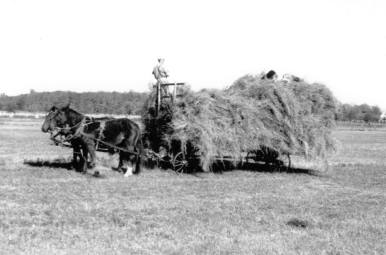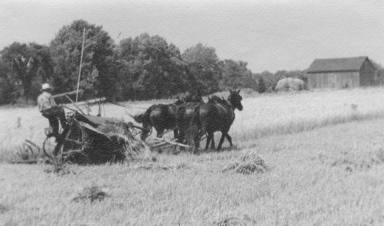
The Symphony Of The Seasons (page
3)
SUMMER
Summer was surely here when we could roll up our sleeves, put on our straw hats, and
exclaim "My land, ain't it hot today!"
Summer also meant school vacation time, with two or more months of footloose freedom
from school. It meant freedom to play, when Ma and Pa allowed us to play, and freedom to
help with the farm chores when Pa and Ma thought we should.
The hay mow was a favourite place to play -- jumping from that high-up beam into the
soft, yielding hay. We could even help to trample the hay after it had been placed by our
Ma -- she always wore a dress, never overalls or pants like most farm women -- with her
pitchfork and straw hat. Just helping when necessary was also fun, sometimes.
Summer was when we delighted to run free in loose-fitting overalls and jersey top.
Summer was when the swimming-hole beckoned us for a splash and a chance to at least
"dog paddle" as we called it. (None of us ever did learn to swim as did the
other neighbour kids.)
Summer was the time when we hated to get dressed in our Sunday best and go to Meeting,
there to sit quietly on hard, grey benches. The monotony was sometimes broken by the
swish, swish of a palm-leaf fan as Ma tried to keep us cool. The lure of the out-of-doors
beckoned when the Meetinghouse doors would be left open to let some stray breeze drift in.
Spring rains and warm sun have produced an abundance of grass which is now ready for
cutting. We call this "Haying". Pa has readied the mower, oiled all the bearings
and moving joints and sharpened the cutting bar. Brother Earl has harnessed the work team
Maude and Nancy, hitched them to the mowing machine, and is away to the hay-field in the
"Back Forty". Haying is about to begin.
Hay in the "Back Forty" consists of a mixture of alfalfa and timothy plus an
assortment of weeds, including the Canada thistle. In due time, that is following a day or
two drying in the sun, comes the raking. Hay-raking is a job for old Duke hitched to the
dump-rake, with myself as driver. We gather the hay into "windrows", Then with a
pitch-fork it is made into piles we call "coils" or "haycocks", to
make it easier to load onto the wagon.
 After
several hot days, the hay should be ready to be brought to the barn for storage. The day
looked warm and bright, so, with Maud and Nancy hitched to the wagon with hay rack and
slings in place, we were ready for a day of hauling in. Pa, Ma, Earl and myself were to do
the job. Pa, Ma and Earl each had pitch-forks. We each wore straw hats for protection from
the hot sun. Pa and Ma would work on the ground, pitching the hay onto the wagon, where
Earl would spread it to make a balanced load. I was allowed to drive, so I would perch on
the front ladder of the rack and with the reins held tightly in both hands guide the
horse-drawn wagon around the field, from coil to coil. I had learned my Gees and Haws
almost as well as the horses had. With a tug here on the reins, or a slap here and there,
it was quite enjoyable being the driver of a wagon load of hay.
After
several hot days, the hay should be ready to be brought to the barn for storage. The day
looked warm and bright, so, with Maud and Nancy hitched to the wagon with hay rack and
slings in place, we were ready for a day of hauling in. Pa, Ma, Earl and myself were to do
the job. Pa, Ma and Earl each had pitch-forks. We each wore straw hats for protection from
the hot sun. Pa and Ma would work on the ground, pitching the hay onto the wagon, where
Earl would spread it to make a balanced load. I was allowed to drive, so I would perch on
the front ladder of the rack and with the reins held tightly in both hands guide the
horse-drawn wagon around the field, from coil to coil. I had learned my Gees and Haws
almost as well as the horses had. With a tug here on the reins, or a slap here and there,
it was quite enjoyable being the driver of a wagon load of hay.
After the third load was safely stowed away in the west mow of the barn, we were told
by Auntie, who was the cook for the day, that dinner was now ready. "Hurrah! What
welcome news!"
We guessed that another three or four loads would clear the field. We need to get an
early start after dinner. Already, the weather was changing. Those scudding clouds had
scudded together and it began to look a lot like rain, maybe a thunderstorm. Now, more
speed was necessary as we anxiously watched the gathering storm. This was the last load
and one or two more coils to load on. The sky darkened and a breeze sprang up with a feel
of rain in the air. We trotted the horses with this precious load of hay into the barn.
Just as we reached the doors, it began to sprinkle. In a short time, the team was put away
and we all made a dash for the house.
A welcome supper awaited us and we gave thanks that we were able to get this last load
in the barn ahead of the rain.
With the haying successfully finished, we would now have to turn our attention to many
other things.

The Wheat Harvester
The old grain binder, a three-horse team, and a driver
|
On our farm there were always fences to be repaired. Some of our fences were rail
fences, and they did require constant attention. Then there were always buildings to be
fixed here and there, never an idle moment.
Summer was when we would look forward to a visit from Ma's folks away down in
Pennsylvania. It might be either Uncle Jess and his family of four boys, or Uncle Sam and
Aunt Jessie and their two boys. These occasions were times to remember. Ma was very fond
of her own family from down Home.
Summer invokes memories of garden hoes; of filing the edge sharp to make hoeing easier.
There were always endless rows of corn, potatoes and beans to be hoed, often in the heat
of the day. Summer labour always meant consuming gallons of lemonade or iced tea, even
just plain water, to quench the thirst of sweaty throats.
Summer recalls the memories of pulling that wild, yellow mustard and the equally
noxious Russian sow thistle in the fields of wheat or oats. This was the environmental way
of weed eradication. Then there was the tedious job of potato debugging, with pail and
paddle, row after row, knocking these injurious insects into this pail awaiting execution.
This, too, was the environmentally friendly way.
I see Ma working in her garden, in the cool of the evening, hoeing and then stooping to
carefully pull every weed from her beautiful garden.
Frequently, we would all gather on the steps of the front porch in the delightful cool
of the evening to relax and give a silent thanks for another day successfully drawing to a
close. The birds would say their goodnight in their own ways and then a bullfrog down in
the marsh would have his say as well. Now it is time for all those barefoot boys to wash
their feet at the pump, and then, later as darkness settled down, indoors to bed. Must not
go to bed with dirty feet.
Before my time, the hand reaper had given way to the more sophisticated machine we
called the "Binder". This was an ingenious machine requiring a four-horse team
to pull. From this invention, later developed the "Combine" in its several
forms. A series of rotating slats, called a "reel" forced the standing stalks of
grain against the cutting bar. These were then carried on a series of canvas belts or
aprons, to a binding device that bound into a neat bundle using Binder Twine. These
bundles were discharged to the ground where they would later be manually picked up and
made into "shocks" or "stooks".
After several days of drying in the sun -- hoping for dry weather in the meantime --
these sheaves would be hauled by wagon to the barn, where they would wait the time of
"threshing".
Next (page 4)
Dedication Acknowledgements Preface A Word About The
Author
Where It All Began My
Beginning The Days Of My Youth
Home-Made Bread And Farmer's Market
Patent No. 261912
Some Rural Characters And Events
The Party Line Telephone
My Ma And Pa The House Where I Was Born
The Symphony Of The Seasons Trial And Error Down
South -- A Family Vacation Outward And
Onward A Profile Of Me
Prophetic Vision From The Back Forty Epilogue
Copyright © by Ken Muma
For more...please visit Hayseed
Philosophy
 After
several hot days, the hay should be ready to be brought to the barn for storage. The day
looked warm and bright, so, with Maud and Nancy hitched to the wagon with hay rack and
slings in place, we were ready for a day of hauling in. Pa, Ma, Earl and myself were to do
the job. Pa, Ma and Earl each had pitch-forks. We each wore straw hats for protection from
the hot sun. Pa and Ma would work on the ground, pitching the hay onto the wagon, where
Earl would spread it to make a balanced load. I was allowed to drive, so I would perch on
the front ladder of the rack and with the reins held tightly in both hands guide the
horse-drawn wagon around the field, from coil to coil. I had learned my Gees and Haws
almost as well as the horses had. With a tug here on the reins, or a slap here and there,
it was quite enjoyable being the driver of a wagon load of hay.
After
several hot days, the hay should be ready to be brought to the barn for storage. The day
looked warm and bright, so, with Maud and Nancy hitched to the wagon with hay rack and
slings in place, we were ready for a day of hauling in. Pa, Ma, Earl and myself were to do
the job. Pa, Ma and Earl each had pitch-forks. We each wore straw hats for protection from
the hot sun. Pa and Ma would work on the ground, pitching the hay onto the wagon, where
Earl would spread it to make a balanced load. I was allowed to drive, so I would perch on
the front ladder of the rack and with the reins held tightly in both hands guide the
horse-drawn wagon around the field, from coil to coil. I had learned my Gees and Haws
almost as well as the horses had. With a tug here on the reins, or a slap here and there,
it was quite enjoyable being the driver of a wagon load of hay.
